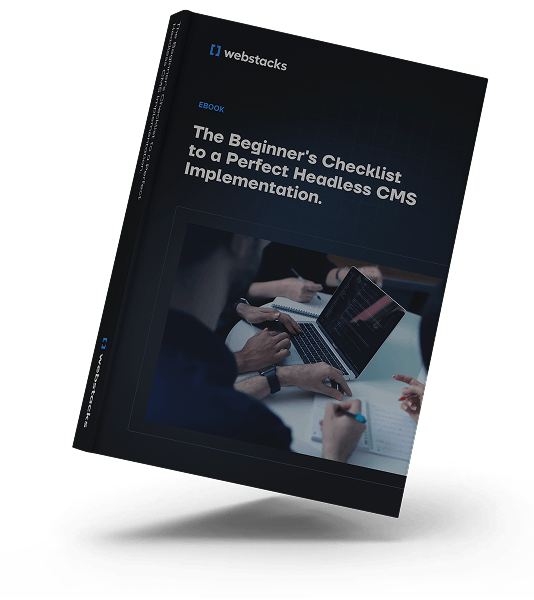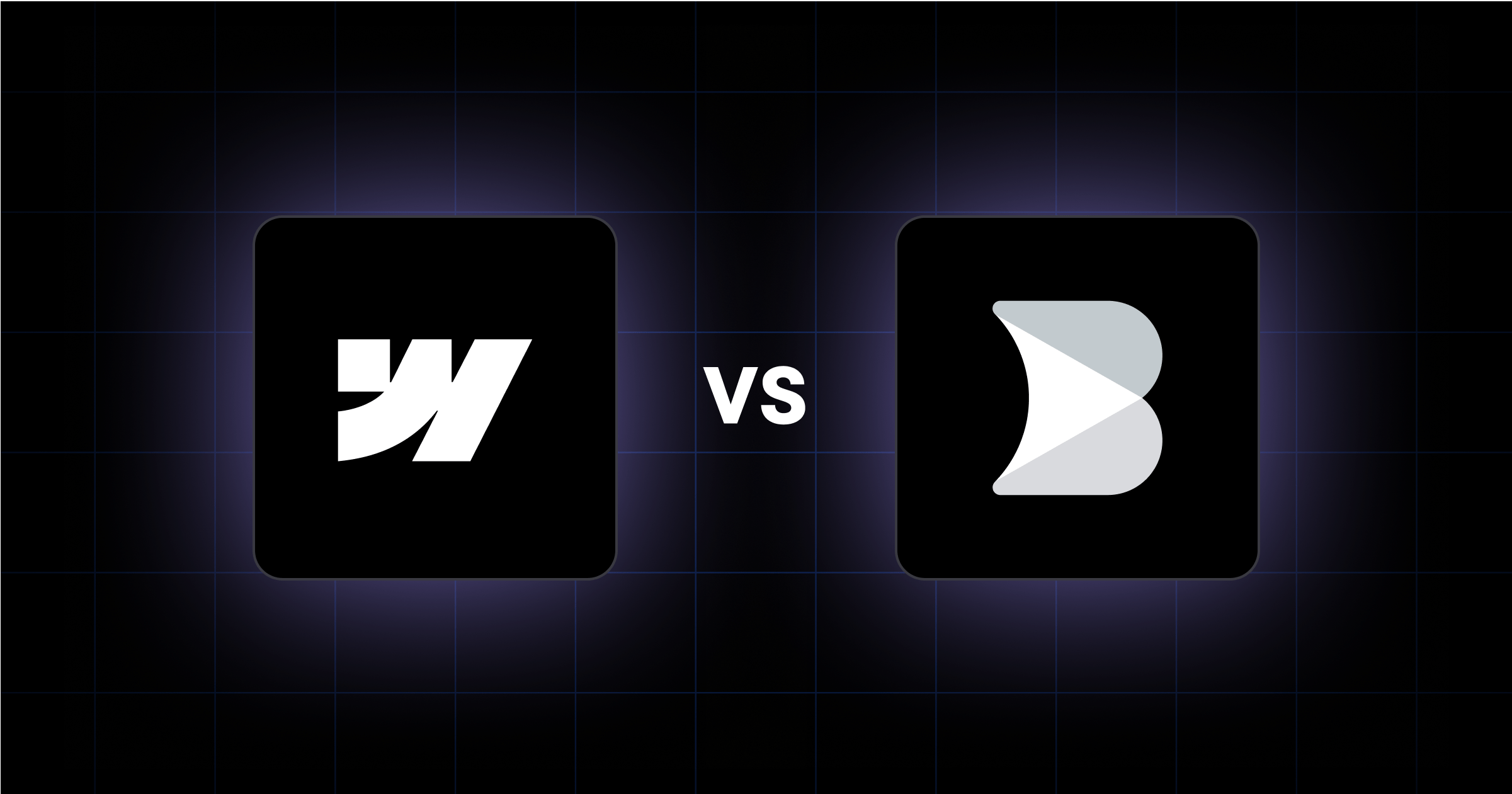As a web development agency, Webstacks has helped dozens of B2B teams implement both Webflow and Builder.io.
We’ve seen how choosing the right CMS can accelerate launches, improve performance, and give teams more control over their content.
For companies that need to move quickly without sacrificing design consistency or scalability, headless architecture often offers the best path forward. But it all depends on your unique business priorities.
In this guide, we’ll compare Webflow and Builder.io, break down who each platform is best suited for, and help you evaluate them.
How Webflow and Builder.io Approach Content Management
Webflow is an all-in-one visual development platform. It combines website design, content management, and hosting. It’s a go-to for lean teams that want speed and don’t need deep technical support. Marketers can create and publish landing pages and update content independently.

Builder.io, by contrast, is a headless CMS built for composable architectures. It allows marketers to visually edit pages using developer-defined components. It's meant to live within your existing frontend, integrating directly with frameworks like Next.js, React, or Vue.
When to Use Webflow and When to Go For Builder.io
The best way to evaluate these platforms is by looking at how they perform in real business scenarios.
Choose Webflow if you’re moving fast with limited dev support.
We often recommend Webflow for startups that need to get a marketing site live quickly. It’s ideal when your team is small, your product is evolving, and you need marketers to launch and iterate on pages without engineering help.
Choose Builder.io if you’re scaling fast and need flexibility. Builder.io is better suited for growth-stage or enterprise teams with more complex demands. It’s great for teams running frequent campaigns, experimenting with personalization, or managing content across multiple markets.
Discover how Trust Machines implemented Builder.io with the help of Webstacks.
How Webflow and Builder.io Support Different Teams
Let’s look at the way Webflow and Builder.io compare across various use cases for B2B marketing and digital teams.
1. Team Autonomy and Speed to Launch
Webflow is great when you need to move quickly without relying on engineers.
Marketers can create, edit, and publish pages in a completely visual interface. This is ideal for early-stage companies or lean teams without dedicated web developers. But speed sometimes comes at the cost of flexibility.
Builder.io offers similar autonomy, but within a developer-built frontend.
Developers set the foundation, and then marketers can visually build and edit content using approved components.
2. Content Complexity
Webflow works best when your content is relatively flat. Examples include blog posts, landing pages, team bios, etc. Its CMS is flexible for basic use cases but starts to show limitations when content needs to be reused across regions, products, or dynamic layouts.
Builder.io allows you to define structured content models and reuse components. The CMS does a great job for B2B teams managing multiple product lines, microsites, or highly modular content.
3. Personalization and Experimentation
If you’re aiming for advanced testing or personalization, Builder.io has a clear advantage. It integrates with analytics platforms and personalization tools. The CMS allows teams to run A/B tests and dynamically serve content based on user behavior or region.
Webflow doesn’t offer this out of the box. While you can work around it with third-party tools, it’s not built with experimentation in mind.
4. Scalability and Workflow Governance
Webflow keeps things simple, which is great early on, but limiting later.
Role-based access, publishing workflows, and localization controls are basic at best. For startups, that might be enough. But for enterprises or teams with multiple stakeholders, that simplicity can become a bottleneck.
Builder.io is built to scale with your organization. It supports granular permissions, draft workflows, and multisite architectures, which is perfect for big marketing teams. If governance and scalability are top priorities, Builder.io is a better long-term fit.
5. Developer Experience and Stack Compatibility
Webflow is a closed ecosystem. While it’s powerful for what it does, you’re locked into its visual editor and hosting stack. It’s not the best choice if you want full control over performance, design systems, or code standards. It can also be challenging to implement advanced SEO strategies.
Builder.io, by contrast, integrates directly into your frontend codebase.
Developers maintain control over the experience, while marketers gain visual editing within defined constraints.
How Do Webflow and Builder.io Integrate With Your Tech Stack?
When evaluating a CMS, it’s important to see how it integrates into the rest of your stack.
Webflow is a self-contained platform. You design, build, and host your site all within Webflow’s ecosystem, which simplifies setup and reduces technical overhead.
That’s part of its appeal—especially for early-stage startups or small teams that don’t have the resources to manage infrastructure.
But that simplicity comes with tradeoffs. If you need to integrate Webflow into a more complex stack, such as external personalization engines, you’ll run into limitations quickly. In such cases, a Webflow migration to a headless CMS becomes necessary.
Builder.io is more extensible and offers the flexibility to integrate with different tools such as Figma and Crowdin.
Other CMS Platforms to Consider
If Webflow and Builder.io don’t feel like the perfect match, there are other headless and hybrid CMS options that may better align with your team’s goals. Here are a few worth exploring:
- Sanity: A highly flexible CMS that lets you customize everything from content structure to the editing interface. Ideal for teams with in-house dev support who need full control.
- Contentful: Known for its scalability and structured content modeling. A strong fit for enterprise teams managing content across multiple sites, regions, or product lines.
- Storyblok: Combines visual editing with structured content. Great for marketing teams that want freedom without giving up governance.
- Prismic: Built for speed and simplicity. A good option for lean teams that want to launch fast and don’t need complex workflows.
We also recommend downloading our headless CMS implementation checklist to have a better idea of what to expect if you’re going headless:

Explore more of our CMS guides:
Need Help Choosing the Right CMS?
Whether you’re launching your first marketing site or scaling a global content operation, your CMS decision matters and we can help you get it right.
Webstacks partners with B2B teams to evaluate and implement the CMS platforms that support speed and long-term growth.
We’ve launched dozens of composable websites for startup and enterprise brands. So, we know the trade-offs and can help you avoid expensive mistakes.
Let’s talk about your goals and what platform makes the most sense for your team.




